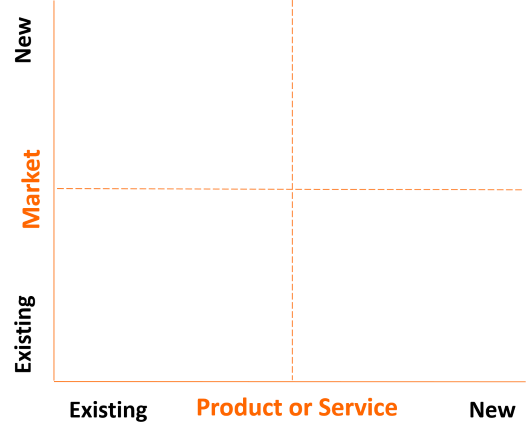Organisational growth strategies
Every type of organisation needs to grow, whether they are a StartUp, a ScaleUp or a large multi-national. The Ansoff Matrix, first published in 1957 by H. Igor Ansoff in the Harvard Business Review, helps to answer how to do this.
On the Y axis is “Market”. This is best understood as a customer group. If you want to understand how to define these, please see this post. This is also known as the Ideal Customer Profile (ICP). Targeting an ICP helps you maximise revenue. On the X axis is “Product”, in the example below, I have called this “Product or Service”. This represents what you offer, which could be a physical product, a digital product or a service.
Each Axis is labelled with Existing or New. This should be self-explanatory. For example, targeting a new market means going after a different set of customers.
The matrix quadrants
These quadrants are given descriptions. Starting with the Diversification quadrant, this means a new product or service sold to a new customer group (market). This is the highest-risk approach.
A StartUp will be operating in diversification and will be testing different business models with different customer groups. The organisation will be stable only when product-market fit is achieved. In this case a StartUp may need to pivot its market or solution depending on initial success.
Choices for existing organisations
Below, you can see the four options that an existing organisation has. Understanding when to take each growth strategy is key to success.
Where to start
An existing organisation should focus on Market Penetration. Maximise your opportunities here, as this represents the lowest risk.
Growth strategies
Improve your marketing
Adjust pricing to be more competitive / achieve higher profit
Competitor acquisition
Anti-patterns
Your target customer group isn’t well-defined. This means you are getting conflicting feedback from customers, and your product offering isn’t optimised. Although this can feel good as you aren’t “Leaving money on the table”, in reality, you are being dragged in different directions, leading to less success. Organisations with an unlimited capacity for development wouldn’t be affected by this. However, almost all have limits to what they can build.
Another big anti-pattern is to shift away from your target customer group too early. This means moving into the Market Development quadrant. Despite this looking like an obvious expansion opportunity, these customers may have different needs. This will stretch your organisation as you cater for them. You may then find your product development is less effective as you try and satisfy two customer groups, with the risk of pleasing neither and more focussed competition overtaking you.
If you pivot too far from your current customer group, they can expect a very different product so be careful how different they are. Use personas to be clear on your new customer group and conduct research on their needs to validate this.
What about the other options?
When do you think you should choose each of the three other scenarios?
Select Market development when:
Existing customer base is saturated
Opportunity to sell to another customer group
Select Product development when:
There is spare capacity to invest
Current customers express a need you can fulfil
Brand loyalty is strong
Select Diversification (highest risk) when:
Major opportunity for success
Related diversification: Synergies with a new market & product are high, therefore expertise can be utilised
Unrelated diversification: A new product or service can improve how the organisation operates, e.g. Amazon creating a shipping business.
Summary
The Ansoff Matrix is a simple but effective tool for understanding how and when to grow your organisation. Using this as part of your regular strategy reviews is an excellent way to maximise your revenue potential.
Have you used the Ansoff Matrix, how did it go? Leave your thoughts below….






